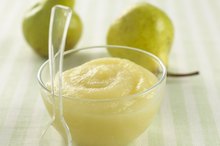How to Make Balsamic Vinegar From Wine
Balsamic vinegar takes time, as in more than a decade, minimum. The technique itself is simple and hardly differs from making regular red wine vinegar -- until you get to aging. Genuine balsamic vinegar, or aceto balsamico tradizionale, undergoes at least 12 years of oak-barrel aging to impart vanilla, cherry and oak flavors that make it grand 1. The timely option for making balsamic vinegar, one you don't have to wait until retirement age to enjoy, is balsamic vinegar of Modena, a commercial grade of balsamic vinegar made by caramelizing red wine vinegar and aging it for two months 1.
Dilute the wine with a wine-bottle full of distilled water. Vinegar bacteria won't metabolize in wines with 12 percent or high alcohol content.
Vinegar and Kidneys
Learn More
Add the mother of vinegar, which will be a cloudy white clump of cellulose, to a purpose-made crock with a spigot at the bottom. Pour in the wine.
Cover the wine with three layers of cheesecloth. Secure the cheese cloth to the vinegar crock with a rubber band or kitchen string.
How to Remove Chlorine From the Hair & Body
Learn More
Set the vinegar crock in a room with a temperature between 60 and 80 degrees Fahrenheit. The room needs to be dark. A basement or attic works, but so does a closet. You can also place the crock in a cardboard box and place it in a room that stays within the desired temperature range.
Let the bacteria work on the wine for three months. You will know the wine has turned by its smell.
Transfer the vinegar to another container. Discard the mother of vinegar. Strain the vinegar through a sieve lined with a few layers of cheesecloth.
Strain the vinegar again, this time through a sieve lined with a coffee filter. This removes fine sediment.
Transfer the vinegar to a stainless-steel saucepan. Add 2 1/2 cups of sugar to the vinegar.
Simmer the vinegar until it reduces by half in volume. Transfer the vinegar to a sanitized 1-gallon glass jar.
Cover the glass jar with three layers of cheesecloth. Place the vinegar in the dark room to age for at least two months. The longer you age the vinegar, the more complex its flavor. You can age the vinegar indefinitely, but try it after two months and determine if it needs more time according to your tastes.
Tips
For a quick balsamic substitute, mix 1 tablespoon of red wine vinegar with 1 teaspoon of sugar. Allow the sugar to dissolve and combine the vinegar with 1/2 cup of olive oil to make a vinaigrette.
Related Articles
References
- Wine Spectator: How to Make Balsamic Vinegar From Wine
- Serious Eats: Everything You Need to Know About Balsamic Vinegar
- Mitrou P, Petsiou E, Papakonstantinou E, et al. Vinegar consumption increases insulin-stimulated glucose uptake by the forearm muscle in humans with type 2 diabetes. J Diabetes Res. 2015;2015:175204. doi:10.1155/2015/175204
- Beh BK, Mohamad NE, Yeap SK, et al. Anti-obesity and anti-inflammatory effects of synthetic acetic acid vinegar and Nipa vinegar on high-fat-diet-induced obese mice. Sci Rep. 2017;7(1):6664. Published 2017 Jul 27. doi:10.1038/s41598-017-06235-7
- Kondo T, Kishi M, Fushimi T, et al. Vinegar intake reduces body weight, body fat mass, and serum triglyceride levels in obese Japanese subjects. Bioscience, Biotechnology and Biochemistry. 2009. doi:10.1271/bbb.90231
- Guo X, Xu Y, He H, et al. Visceral fat reduction is positively associated with blood pressure reduction in overweight or obese males but not females: an observational study. Nutr Metab (Lond). 2019;16:44. doi:10.1186/s12986-019-0369-0
- Johnston CS, Steplewska I, Long CA, Harris LN, Ryals RH. Examination of the antiglycemic properties of vinegar in healthy adults. Ann Nutr Metab. 2010;56(1):74-9. doi:10.1159/000272133
- White AM, Johnston CS. Vinegar ingestion at bedtime moderates waking glucose concentrations in adults with well-controlled type 2 diabetes. Diabetes Care. 2007;30(11):2814-5. doi:10.2337/dc07-1062
Resources
Tips
- For a quick balsamic substitute, mix 1 tablespoon of red wine vinegar with 1 teaspoon of sugar. Allow the sugar to dissolve and combine the vinegar with 1/2 cup of olive oil to make a vinaigrette.
Writer Bio
A.J. Andrews' work has appeared in Food and Wine, Fricote and "BBC Good Food." He lives in Europe where he bakes with wild yeast, milks goats for cheese and prepares for the Court of Master Sommeliers level II exam. Andrews received formal training at Le Cordon Bleu.









